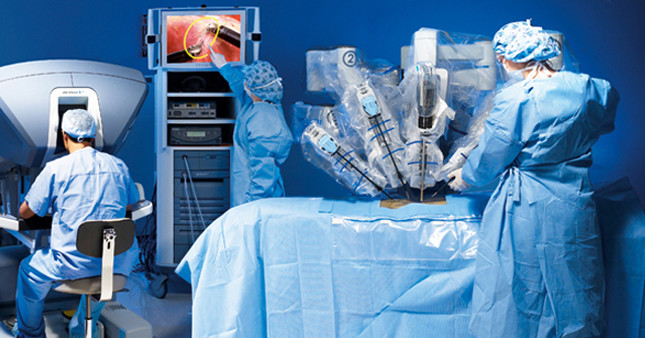In the surgical treatment of apical prolapse, vaginal and abdominal method are used. Endoscopy options are also available for the abdominal method.
Surgical treatment of apical prolapse:
- Vaginal method
- Sacrospinous ligament fixation
- Vaginal mesh
- Posterior IVS
- High uterosacral plication
- Abdominal method
- Open sacrocolpopexy
- Laparoscopic sacrocolpopexy / cervicopexis
- Robotic sacrocolpopexy / cervicopexis
Although many operations have been described in the treatment of apical prolapse, most commonly used operations are sacrospinous fixation and abdominal sacrocolpopexy. According to Cochrane’s evidence-based data, there are three studies comparing two methods in the literature. According to the results of these studies, abdominal sacrocolpopexy is an operation with high success rate despite high morbidity rate and it has been considered as gold standard for the treatment of apical prolapse for long years. The increase in the use of mesh (surgical kit) after 2000 has led to this operation to be preferred as second procedure. In recent years, after the warnings of FDA related to mesh complications, sacrocolpopexy operations have gained popularity again.
Sakrohisteropexy was first described by Arthure in 1957. In 1962, Lane described sacrocolpopexy. The most important disadvantage of this gold standard is the opening of the abdomen, the high complication-morbidity associated with it, and the long time required to return normal activities. In order to overcome these disadvantages of open surgery, sacrocolpopexy was performed laparoscopically.
Advantages of laparoscopy:
- Trauma is mild.
- Risk of infection decreased
- Low blood loss after surgery
- Pain is less
- Less hospitalization period
- Recovery period and time required to return to daily activities
- Cosmetic appearance is better
The disadvantage of this superior laparoscopic approach is the long learning curve and the difficulty of suturing. In 2005, it was started to be performed in gynecology with robotic surgery and sacrocolpopexy. Robotic practice has eliminated the difficulties in suturing and learning curve which are the most important disadvantages of laparoscopy.
Robotic surgery includes the following advantages in addition to the advantages of laparoscopy to open surgery.
- Tremor filtration
- Motion control
- 3D vision
- Independent 7-degree endowrist instruments
- Use of 3rd handle for traction and retraction
Besides these advantages of the surgeon, the patient also has advantages.
- Less postoperative pain
- Less bleeding
- Less transfusion
- Less infection risk
- Less scar
- Increased cosmetic appearance
- Quick recovery
- Good anatomic correction and success rates
The surgeon also has important advantages in robotic surgery.
- Better visualization of the pelvis
- Easy and accurate plane dissection
- Easy management of sutures and mesh.
- Easy, quick and smooth intracorporeal suturing
- Providing autonomy and efficiency with control of camera and 3rd arm
- Easier learning, practice and teaching
- Less shoulder and muscle pain
In addition to these advantages, the three major disadvantages are the lack of tactile sensation, the inability to change patient position during the operation and to be expensive.
Selsen et al evaluated the study of 12 robotic sacrocolpopexy studies from 2004-2014. A total of 350 patients were followed for 13.5 months and the success rate was 97%. The duration of operation was 203 minutes, conversion rate was 3.4%, intraoperative complication was 4.6%, periop complication rate was 7.1%. Erosion rate was 2.5%.
Elliot et al, Li et al, Geller et al. compared robotic sacrocolpopexy with open sacrocolpopexy. Elliot et al. found out that the duration of operation are similar and hospitalization duration to be less than the robot group (1 vs. 3.3). According to Geller et al., while the operation time was found to be longer in the robotic group, they found that roboti has better conditions for postoperative antigens support, mean amount of hemorrhage and length of hospitalization. Li et al. found less hospitalization, bleeding and postoperative complications, more intraoperative complications and cost in the robotic group.
Judd et al. compared robotic, laparoscopic and open sacrocolpopexy. Robot and laparoscopy were found to be advantageous in robotic operation time and cost parameters.
| Robotics | Laparoscopic | Abdominal | |
| Op. duration (minutes) | 328 | 269 | 170 |
| Conversion (%) | 1.4 | 1.8 | — |
| Transfusion (%) | 1.4 | 1. | 3.8 |
| Duration of hospitalization (days) | 1 | 1.8 | 2.7 |
| Cost (dollar) | 8508 | 7553 | 5792 |
Serati et al. found that robotic surgery was reliable, effective and feasible in the meta-analysis of 27 studies in which 1448 cases were compared with open, laparoscopic and robotic sacrocolpopexy.
Robotic sacrocolpopexy is a minimally invasive, high success rate operation that does not include morbidity and complications of open sacrocolpopexy which is the gold standard in the treatment of apical prolapse. It is used increasingly.
